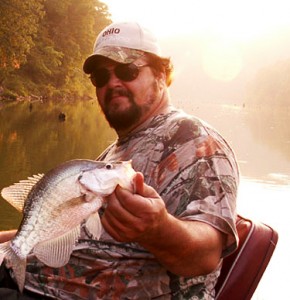Editor’s Note: This piece first appeared in the Greater Ashland Beacon on Oct. 5, 2011.
By Chris Erwin
The leaves are starting to fall, and your favorite crappie hole seems to be vacant. The truth is it may very well be void of fish during the transition.
I talk a lot about the transition in the fall because once you understand it you will forever be influenced by this natural occurrence that baffles many good fishermen and usually leads to an early end of the season.
Before we get into exploring fall crappie patterns, it is worth bringing up to any new anglers trying to learn about different species of fish that crappie are one of the sport fish that will take your bait 365 days a year. They will feed through the ice if you locate them, so the notion that cooler weather somehow equates to not catching these fish absolutely does not apply.

I do believe that live minnows may out shine a jig during this time. However, the jigs will still work and some cases they are used together.
They are two factors that scatter crappie in the fall. The first is cooling water that blurs the thermo cline. When this happens, the water can be the same temperature from top to bottom. This is before the turn over. The turn over occurs when the water on the top becomes colder than the water underneath. When this happens, the water on top sinks and the water on bottom rises to the top. We are weeks from this occurring.
While in the transition, crappie will scatter but the rule for finding fall fish applies: Follow the bait fish. Bass guys will be hitting the back of coves and working their way towards the point. Crappie fishermen will be fishing the stick ups, standing trees that are close to the channel in coves and the outside bends in rivers or creeks.
I have interviewed many crappie fishermen over the years that seem always to know right where the crappie is while the transition is in full swing. They all have a few things in common. They move from stick up to stick up spending time dropping their bait as close to the stick up or standing trees as possible. They may hit a spot that produces a few fish or a lot of fish, but the key is move if you’re not getting hits. It’s also a good time to go to a slip bobber so you can change your depth until you find the depth that starts producing. A long rod is also useful while fishing this pattern; many anglers will use a 12 to 14 foot rod.
Once you find trees or stick ups that are holding fish, it’s good to remember them. They will produce year after year during the transition.
Most of the lakes in eastern Kentucky have standing timber and the place to start is in coves or rivers and creeks that feed the lake. This is the place that the shad will migrate to as we work through the transition. Every lake in our area will be a little different but the basics are tried and tested. While fishing reports may become slow, they are some fishermen who catch more fish during this time than they do all year.
It has been said over and over that 90 percent of the fish are in 10 percent of the lake. Once you eliminate dead water the time you spend on the water will become a lot more fun.
Instead of putting up your gear, get out there, find the fish and put some in the boat. Then take some pictures and send them to me. I would love to hear about your successes or your problems finding fish. We are here to help you have more fun on the water.
Till Next Time
Good Fishing!


Be the first to comment